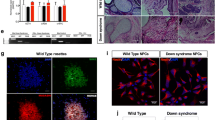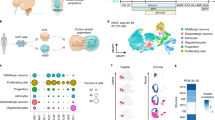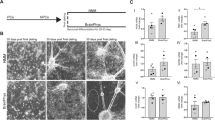Abstract
Neuropeptide Y (NPY)-containing neurons are depleted in the cortices of individuals with Alzheimer disease (AD), yet spared in the striatum of patients with Huntington chorea. It is unknown whether this neuronal phenotype is inherently susceptible to the neurodegenerative processes that are a hallmark of AD. To study this question, the murine trisomy 16 model of Down syndrome and Alzheimer disease was investigated. Since trisomic fetuses diein utero, studies were carried out on primary cultures of dissociated cortical neurons. These were prepared from 15-d gestational trisomy 16 fetuses and their littermate euploid controls, and examined by immunocytochemical staining for neuropeptide Y at 7 and 12 d in vitro. Trisomy 16 neurons were also grown on euploid glial carpets, whereas euploid neurons were grown on trisomic glia. The results demonstrate a significant increase in the number of NPY neurons and a stunting in the dendritic arbor of these neurons in trisomic vs euploid cortex. Both of these parameters could be normalized by direct contact with euploid glia. When euploid cortex was plated on trisomic glia, the number of NPY neurons and their morphology were altered so that they began to resemble trisomic NPY cortical neurons. These results indicate a dysregulation of NPY neuronal expression and differentiation in trisomy 16 cortex that are modifiable by interaction with euploid glia and imply an abnormal trophic (glial) environment in trisomic cortex.
Similar content being viewed by others
References
Ault B., Caviedes P., and Rapoport S. I. (1989) Neurophysiological abnormalities in cultured dorsal root ganglion neurons from the trisomy 16 mouse fetus, a model for Down syndrome.Brain Res. 485, 165–170.
Beal M. F., Mazurek M. F., Chatta G. K., Svendsen C. N., Bird E. D., and Martin J. B. (1986a) Neuropeptide Y immunoreactivity is reduced in cerebral cortex in Alzheimer’s patients.Ann. Neurol. 20, 282–288.
Beal M. F., Mazurek, M. F., Svendsen C. N., Bird E. D., and Martin J. B. (1986b) Widespread reduction of somatostatin like immunoreactivity in the cerebral cortex in Alzheimer’s disease.Ann. Neurol. 20, 489–495.
Bendotti C., Hohmann C., Forloni G., Reeves R., Coyle J. T., and Oster-Granite M.-L. (1990) Developmental expression of somatostatin in mouse brain: II. In situ hybridization.Dev. Brain Res. 53, 26–39.
Caserta M. T., Corsi P., Oster-Granite M.-L., and Coyle J. T. (1990) Increased number of somatostatin-immunoreactive neurons in primary cultures of trisomy 16 mouse cortex.Mol. Brain Res. 7, 269–272.
Chan-Palay V. (1987) Somatostatin immunoreactive neurons in the human hippocampus and cortex shown by immunogold/silver intensification on vibratome sections: co-existence with neuropeptide Y neurons, and effects in Alzheimer-type dementia.J. Comp. Neurol. 260, 201–223.
Cheng S. V., Nadeau J. H., Tanzi R. E., Watkins P. C., Jagadesh J., Taylor B. A., Haines J. L., Sacchi N., and Gusella J. F. (1988) Comparative mapping of DNA markers from familial Alzheimer’s disease and Down syndrome region of human chromosome 21 to mouse chromosomes 16 and 17.Proc. Natl. Acad. Sci. USA 85, 6032–6036.
Chronwall B. M., Chase T. N., and Donohue T. L. (1984) Coexistence of neuropeptide Y and somatostatin in rat and human cortical and hypothalamic neurons.Neurosci. Lett. 52, 213–217.
Corsi P. and Coyle J. T. (1991) Nerve growth factor corrects developmental impairments of basal forebrain cholinergic neurons in the trisomy 16 mouse.Proc. Natl. Acad. Sci. USA 88, 1793–1797.
Coyle J. T., Price D. L., and Delong M. R. (1983) Alzheimer’s disease: a disorder of cortical cholinergic innervation.Science 219, 1184–1190.
Coyle J. T., Oster-Granite M. L., Reeves R., Hohmann C., Corsi P., and Gearhart J. (1991) Down Syndrome and the trisomy 16 mouse: Impact of gene imbalance on brain development and aging, inGenes, Brain and Behavior (McHugh P. R. and McKusik V. A., eds.), Raven Press, New York.
Davies P., Katzman R., and Terry R. D. (1980) Reduced somatostatin-like immunoreactivity in cerebral cortex from cases of Alzheimer’s disease and Alzheimer senile dementia.Nature 288, 279,280.
Davies C. A., Morroll D. R., Prinja D., Mann D. M. A., and Gibbs A. (1990) A quantitative assessment of somatostatin-like and neuropeptide Y-like immunostained cells in the frontal and temporal cortex of patients with Alzheimer’s disease.J. Neurol. Sci. 96, 59–73.
Davisson M. T., Schmidt C., Reeves R. H., Irving N. G., Akeson E. C., Harris B. S., and Bronson R. T. (1993) Segmental trisomy as a mouse model for Down syndrome, inThe Phenotypic Mapping of Down Syndrome and Other Aneuploid Conditions (Epstein C. J., ed.), pp. 117–133, Wiley-Liss, New York.
Epstein C. J. (1986)Consequences of Chromosome Imbalance: Principles, Mechanisms and Models. pp. 253–322, Cambridge University Press, New York.
Ferrier I. N., Cross A. J., Johnson J. A., Roberts G. W., Crow T. J., Corsellis J. A. N., Lee Y. C., O’Shaughnessy D., Adrian T. E., McGregor G. P., Barcese-Hamilton A. J., and Bloom S. R. (1983) Neuropeptides in Alzheimer’s type dementia.J. Neurol. Sci. 62, 159–170.
Forloni G., Hohmann C., and Coyle J. T. (1990) Developmental expression of somatostatin in mouse brain I. Immunocytochemical studies.Dev. Brain Res. 53, 6–25.
Hardy J., Adolfsson R., Alafuzoff I., Bucht G., Marcusson J., Nyberg P., Perdahl E., Webster P., and Winblad B. (1985) Transmitter deficits in Alzheimer’s disease.Neurochem. Int. 7, 545–563.
Hendry S. H. C., Jones E. G., and Emson P. C. (1984) Morphology, distribution and synaptic relations of somatostatin- and neuropeptide Y-containing neurons in rat and monkey neocortex.J. Neurosci. 4, 2407–2517.
Holtzman D. M., Li Y., DeArmond S. J., McKinley M. P., Gage F. H., Epstein C. J., and Mobley W. C. (1992a) Mouse model of neurodegeneration: atrophy of basal forebrain cholinergic neurons in trisomy 16 transplants.Proc. Natl. Acad. Sci. USA 89, 1383–1387.
Holtzman D. M., Bayney R. M., Berger C. N., Epstein C. J., and Mobley W. C. (1992b) Dysregulation of gene expression in mouse trisomy 16: an animal model of Down Syndrome.EMBO J. 11, 619–627.
Kowall N. W. and Beal M. F. (1988) Cortical somatostatin, neuropeptide Y and NADPH diaphorase neurons: normal anatomy and alterations in Alzheimer’s disease.Ann. Neurol. 23, 105–114.
Lindefors N., Brene S., Herrera-Marshitz M., and Persson H. (1990) Regulation of Neuropeptide Y gene expression in rat brain.Ann. NY Acad. Sci. 611, 175–185.
Nakamura S. and Vincent S. R. (1986) Somatostatin- and neuropeptide Y-immunoreactive neurons in the neocortex in senile dementia of Alzheimer’s type.Brain Res. 370, 11–20.
Nawa H., Bessho Y., Carnahan J., Nakanishi S., and Mizuno K. (1993) Regulation of neuropeptide expression in cultured cerebral cortical neurons by brain-derived neurotrophic factor.J. Neurochem. 60, 772–775.
Orozco C. B., Epstein C. J., and Rapoport S. I. (1988) Voltage activated sodium conductances in cultures normal and trisomy 16 dorsal root ganglion neurons from the fetal mouse.Dev. Brain Res. 38, 265–274.
Orozco C. B., Smith S. A., Epstein C. J., and Rapoport S. I. (1987) Electrophysiological properties of cultured dorsal root ganglion and spinal cord neurons of normal and trisomy 16 fetal mice.Dev. Brain Res. 32, 111–122.
Oster-Granite M. L., Gearhart G. D., Reeves R. H., Singer H. S., Moran T. H., and Coyle J. T. (1987) Down Syndrome and the trisomy 16 mouse, inNeurology and Neurobiology, vol. 33,Animal Models of Dementia: A Synaptic Neurochemical Perspective (Coyle J. T., ed.), pp. 279–307, A. R. Liss, New York.
Phillips H. S., Hains, J. M., Armanini M., Laramee G. R., Johnson S. A., and Winslow J. W. (1991) BDNF mRNA is decreased in the hippocampus of individuals with Alzheimer’s disease.Neuron 7, 695–702.
Plioplys A. V. (1988) Expression of the 210 kDa neurofilament subunit in cultured central nervous system from normal and trisomy 16 mice: regulation by interferon.J. Neurol. Sci. 85, 209–222.
Reeves R. H., Gallaghan D., O’Hara B. F., Callahan R., and Gearhart J. D. (1987) Genetic mapping of Prm-1, Igl-1, Smst, Mtv-6, Sod-1 and Ets-2 and localization of the Down syndrome region on mouse chromosome 16.Cytogenet. Cell Genet. 44, 76–81.
Reinikainen K. J., Riekkinen P. J., Jolkkonen J., Kosma V-M., and Soininen H. (1987) Decreased somatostatin-like immunoreactivity in cerebral cortex and cerebrospinal fluid in Alzheimer’s disease.Brain Res. 402, 103–108.
Richards S. J., Waters J. J., Beyreuther K., Masters C. L., Wischik C. M., Sparkman D. R., White C. L., Abraham C. R., and Dunnett S. B. (1991) Transplants of mouse trisomy 16 hippocampus provide a model of Alzheimer disease related pathology.EMBO J. 2, 297–303.
Rossor M. N., Emson P. C., Mountjoy C. Q., Roth M., and Iversen L. L. (1980) Reduced amounts of immunoreactive somatostatin in the temporal cortex in senile dementia of Alzheimer type.Neurosci. Lett. 20, 373–377.
Rumble B., Retallack R., Hilbich C., Simms G., Multhaap G., Martins R., Hockey A., Montgomery P., Beyreuther K., and Masters C. L. (1989) Amyloid A4 protein and its precursors in Down syndrome and Alzheimer’s disease.N. Engl. J. Med. 320, 1446–1452.
Stoll J., Balbo A., Ault B., Rapoport S., and Fine A. (1993) Long-term transplants of mouse trisomy 16 hippocampal neurons, a model for Down’s syndrome, do not develop Alzheimer’s disease pathology.Brain Res. 610, 295–304.
Unger J., Schwrtzberg M., Weindl A., and Lange W. (1986) Neuropeptide Y in the human and monkey cerebral cortex: colocalization with somatostatin.Neurosci. Lett. suppl 26, S606.
Vincent S. R., Johansson O., Hokfelt T., Meyerson B., Sachs C., Elde R. P., Terenius L., and Kimmel J. (1982) Neuropeptide co-existence in human cortical neurons.Nature 298, 65–67.
Vincent S. R., Johansson O., Hokfelt T., Skirboll L., Elde R. P., Terenius L., Kimmel J., and Goldstein M. (1983) NADPH-diaphorase: a selective histochemical marker for striatal neurons containing both somatostatin and avian pancreatic polypeptide-like immunoreactivities.J. Comp. Neurol. 217, 252–263.
Whitehouse P. J., Price D. L., Struble R. G., Clark A. W., Coyle J. T., and Delong M. R. (1985) Alzheimer’s disease and senile dementia: loss of neurons in the basal forebrain.Science 215, 1237–1239.
Wisniewski K. E., Wisniewski H. M., and Wen G. Y. (1985) Occurrence of neuropathological changes and dementia of Alzheimer disease in Down syndrome.Ann. Neurol. 17, 278–282.
Zoli M., Ferraguti F., Toffano G., Fuxe K., and Agnati L. (1993) Neurochemical alterations but not nerve cell loss in aged rat neostratium.J. Chem. Neuroanat. 6, 131–145.
Author information
Authors and Affiliations
Rights and permissions
About this article
Cite this article
Caserta, M.T. Neuropeptide Y immunoreactive neurons in murine trisomy 16 cortical cultures. Molecular and Chemical Neuropathology 22, 197–210 (1994). https://doi.org/10.1007/BF03160106
Received:
Accepted:
Issue Date:
DOI: https://doi.org/10.1007/BF03160106




